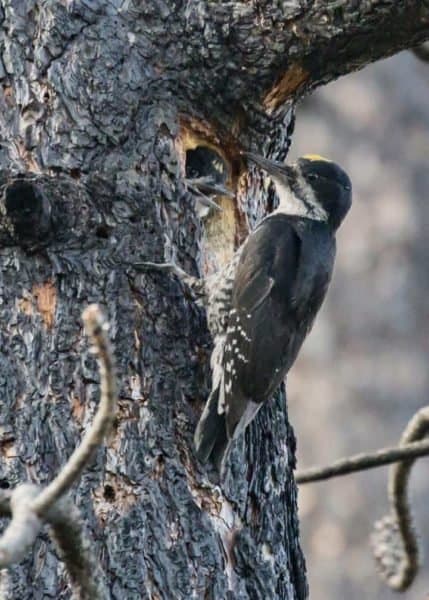Fire is a natural part of western forests, but the changing nature of fire in many parts of North America may pose challenges for birds. One bird in particular, the Black-backed Woodpecker, specializes in using recently-burned forests in western North America, but like humans looking for a new family home, it’s picky about exactly where it settles. New research published in The Condor: Ornithological Applications suggests that these birds actually prefer to nest near the edges of burned patches — and these edges are getting harder to find as wildfires have become bigger and more severe.
Andrew Stillman, a Ph.D. candidate at the University of Connecticut, along with colleagues from The Institute for Bird Populations and the U.S. Forest Service, looked at nest site selection and nest success of Black-backed Woodpeckers in burned forests of northern California. Over a period of eight years, the researchers located and monitored more than one hundred nests while measuring nest site characteristics across multiple spatial scales. The birds in the study strongly preferred to nest in severely burned stands that had lots of dead trees. But the birds chose to place their nests near the edges of these high-severity burned patches, typically within 500 meters of a patch with live trees.
“We didn’t expect to find these woodpeckers nesting so close to edges,” says Stillman. Previous studies had shown that woodpecker nests closer to living forest patches were more likely to be predated by animals such as squirrels. However, another recent study by Stillman and others showed that Black-backed Woodpecker fledglings often move into living patches with good cover quickly after leaving their nest. By placing nests closer to edges, adults may be providing their offspring easier access to this “nursery” habitat.
Stillman notes that “pyrodiversity,” or a diversity in the age, size and severity of burned patches, appears to be important for this post-fire specialist woodpecker because it provides more edges between different burn severities. But climate change is fostering larger, more homogeneous fires with reduced pyrodiversity.
“The thing about pyrodiversity is that we expect it to decrease,” says Dr. Morgan Tingley of the University of Connecticut and co-author of the paper. “Every year we see more ‘mega-fires,’ and these fires are quite homogenous in their structure, leading to low pyrodiversity. So even though the future is expected to hold more fire in western forests, the outlook may not even be good for fire-loving species.”
Stillman anticipates that understanding the importance of habitat edges to Black-backed Woodpeckers, as well as other findings of this study, will assist forest managers. “We hope that these results provide some of the missing information necessary to balance post-fire logging activities with the habitat needs of woodpeckers,” he says. Dr. Rodney Siegel, Executive Director of The Institute for Bird Populations and a co-author of the study, agrees.
“A central goal of our multi-year partnership with the Forest Service is to better understand the specific habitat needs of Black-backed Woodpeckers and other species that use burned forests. This information allows forest managers to design management activities that are more compatible with the needs of wildlife.”
“Nest site selection and nest survival of Black-backed Woodpeckers after wildfire” will be available August 6, 2019, at https:/


